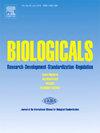目前猴痘病毒检测诊断技术的综合综述
IF 1.5
4区 生物学
Q4 BIOCHEMICAL RESEARCH METHODS
引用次数: 0
摘要
猴痘是由猴痘病毒(MPXV)引起的一种传染病,最初局限于中非和西非,但现在正在全球蔓延。除了在MPXV分型方面面临重大挑战和难以可靠地区分分支外,目前的m痘暴发的临床表现往往是非典型的。因此,仅根据临床体征和症状诊断m痘可能具有挑战性。目前的治疗不是针对MPXV的,主要包括支持性治疗和抑制病毒DNA合成的抗病毒药物,如Tecovirimat和Brincidofovir。本文综述了目前MPXV检测的实验室技术,包括直接和间接诊断方法。它强调了最近的进展,评估了每种方法的优势和局限性,并提出了提高全球诊断能力的创新策略,包括计算药物发现和免疫信息学在设计靶向MPXV及其变体的多表位疫苗中的潜在作用。控制MPXV传播的最有效措施仍然是接种疫苗、及时诊断、隔离受感染个体、保持个人卫生以及避免接触受污染的人、物体和动物粪便。本文章由计算机程序翻译,如有差异,请以英文原文为准。
A comprehensive review of current diagnostic techniques for Monkeypox virus detection
Monkeypox (Mpox) is an infectious disease caused by the Monkeypox virus (MPXV), initially confined to Central and Western Africa, but now spreading globally. The clinical manifestations are often atypical in the current Mpox outbreak, in addition to the critical challenges in MPXV typing and the difficulty in reliably distinguishing between clades. Therefore, diagnosing Mpox based on clinical signs and symptoms only can be challenging. Current treatment is not specific to MPXV and primarily involves supportive care and antiviral drugs that inhibit viral DNA synthesis, such as Tecovirimat and Brincidofovir. This review provides a comprehensive overview of current laboratory techniques for MPXV detection, encompassing both direct and indirect diagnostic methods. It highlights recent advancements, evaluates the strengths and limitations of each approach, and proposes innovative strategies to enhance global diagnostic capabilities, including the potential roles of computational drug discovery and immunoinformatics in designing multi-epitope vaccines targeting MPXV and its variants. The most effective measure to control MPXV spread remains vaccination, timely diagnosis, isolation of infected individuals, maintaining personal hygiene, and avoiding contact with contaminated persons, objects, and animal waste.
求助全文
通过发布文献求助,成功后即可免费获取论文全文。
去求助
来源期刊

Biologicals
生物-生化研究方法
CiteScore
3.70
自引率
0.00%
发文量
39
审稿时长
48 days
期刊介绍:
Biologicals provides a modern and multidisciplinary international forum for news, debate, and original research on all aspects of biologicals used in human and veterinary medicine. The journal publishes original papers, reviews, and letters relevant to the development, production, quality control, and standardization of biological derived from both novel and established biotechnologies. Special issues are produced to reflect topics of particular international interest and concern.Three types of papers are welcome: original research reports, short papers, and review articles. The journal will also publish comments and letters to the editor, book reviews, meeting reports and information on regulatory issues.
 求助内容:
求助内容: 应助结果提醒方式:
应助结果提醒方式:


